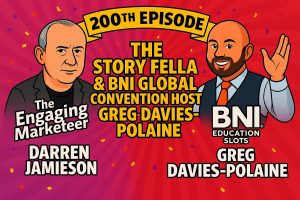Darren Jamieson: On this episode of The Engaging Marketeer, I wanted to talk about why having a massive argument with somebody actually increases your brand, increases your reach, and increases the business you will get. Now, this isn’t me making an excuse for just being a bit of a dick online. There is science to this. There is method to this. There is a real reason why I go around on social media kicking up as much of a fuss, as much of a stink as I possibly can.
For those of you that have followed me, you’ll know all about this. For those that haven’t, I do get into the odd ruck when I’m online. My latest ruck happened a couple of weeks ago when we were having parking wars at our office at Engage Web. We’re having a bit of a disagreement with one of the buildings next to us because they keep parking in one of our spaces.
We each have four spaces for our building and we pay for them. We own the building, and we own the four spaces marked with Engage Web. But one of the neighbouring office buildings keeps having staff or visitors parking in one of those spaces. Frequently, I’ll come back from a meeting or arrive mid-morning and find someone parked in one of our spaces — and it’s not one of our cars.
Now, I don’t care whether it’s my personal space or not. It belongs to the company. Any of our staff can park in it. But not people from other offices. Not randoms off the street. Not just any bastard who wants to park in it. It’s ours. So when I come back and somebody who isn’t one of our team is parked there, it pisses me off because we’ve paid for it.
I keep having arguments with them
I’ve blocked them in. I’ve parked across the back of them. I’ve had people knocking on the door when I’m recording podcasts, when I’m in meetings, even when I’m running online events, saying, “Can you move your car? You’re blocking me in.” And I’ll say, “Yeah, because you’re in my space.”
I had one woman really aggressively have a go at me: “Why did you do that? Why didn’t you park somewhere else?” Well, because that’s my space. Her answer? “When I got here, there were no other spaces.” No — because that was my space. Where did you expect me to park? On the street, or in visitor parking, the same as everyone else does when there are no spaces. One woman even said, “I always park here.” Yes, I know you do. It’s my space. Stop parking in it.
We’ve put labels on the cars, we’ve put stickers on them. Doesn’t do any good — they just ignore it. So I blocked somebody in the other week and thought, you know what, I’ve had enough of this. I took a photo of it and put it on LinkedIn. And I thought, why haven’t I done this before? Why don’t I address this problem the way I address every other problem — publicly online, with some humiliation?
So I did. I took a photo, you couldn’t see the registration so nothing identifiable, and I put the whole story up and asked for advice. What would other people do? And the comments came flooding in. People suggested sunken bollards, branded cones to mark the space, and plenty of people were in favour of blocking them in and going on holiday — which I actually did. They managed to squeeze out, the buggers.
Someone suggested putting down a stinger, like the police use to stop stolen vehicles. Quite a few suggested towing — though that was mostly Americans, as here in the UK you can’t really do that. Some people suggested cling-film wrapping the entire car, which I loved. I might give that one a go. Others suggested spray mount adhesive on the windscreen, which is a nightmare to get off. All fantastic suggestions, and all created a real buzz online.
That post got me over 236 comments and 44,000-plus impressions on LinkedIn. But why? What was the point in putting it online? Am I going to get clients from that post? No, probably not. Am I going to get contacts who think, “Wow, he’s a fun guy, I want to connect with him and maybe get a website off him”? No, probably not. That’s not the reason I did it.
The reason I did it is because LinkedIn, like most social media platforms, loves engagement. LinkedIn wants to see that you’re posting content that people respond to. I’ve had this before on Facebook — even Facebook has messaged me saying, “You’ve been posting some great stuff lately, Daz. We’ve increased your reach as a result.” That’s how it works.
The more engaging your content, the more the platform pushes it out
So, when you post business-related stuff, more people will see it. That’s the strategy. Post content that gets people talking — controversial, entertaining, argument-worthy — and the algorithm rewards you. Then, when you post something sales-related, whether that’s a product, service, event, offer, or lead magnet, more people will actually see it because LinkedIn trusts your content to generate engagement.
You’ll see other marketers do this too. They deliberately post things that stir people up, that cause arguments, that spark conversations, because they know engagement equals reach, and reach equals more conversions when they finally post about something business-related.
That’s how to get LinkedIn and Facebook to dance to your tune. Don’t just post sales crap day after day — “buy my, buy my, buy my” — because nobody cares. Nobody engages, nobody shares, and LinkedIn buries your posts. The platforms want to keep people engaged, not bored.
So do what I did with this parking war story. Post interesting, engaging content. Reply to every comment — and I stress that: reply to every single comment. Because when you reply, people come back, they comment again, and LinkedIn sees that you’re generating real discussion. It pushes your content further, and when your sales post comes, more people will see it and you’ll get more leads.
That’s the way to use LinkedIn effectively. Don’t just spam sales posts. Engage people first, then drop in the business content once your reach has been boosted.
That’s what this podcast is about. Not just my parking war scandal — though that is still ongoing, and I promise there will be a resolution. At some point I’m going to block someone in for a full week and just walk to work. But that’s for another episode.
This one is about using social media effectively. Check out that post on LinkedIn — the link will be in the description — drop a comment, a like, or a share if you fancy it, and I’ll catch you on the next podcast.
About your host:
Darren has worked within digital marketing since the last century, and was the first in-house web designer for video games retailer GAME in the UK, known as Electronics Boutique in the States. After co-founding his own agency, Engage Web, in 2009, Darren has worked with clients around the world, including Australia, Canada and the USA.
iTunes: https://podcasts.apple.com/gb/podcast/engaging-marketeer/id1612454837
LinkedIn: https://www.linkedin.com/in/darrenjamieson/
Engaging Marketeer: https://engagingmarketeer.com
Engage Web: https://www.engageweb.co.uk



